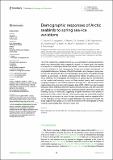Por favor, use este identificador para citar o enlazar a este item:
http://hdl.handle.net/10261/329452COMPARTIR / EXPORTAR:
 SHARE SHARE
 CORE
BASE CORE
BASE
|
|
| Visualizar otros formatos: MARC | Dublin Core | RDF | ORE | MODS | METS | DIDL | DATACITE | |

| Campo DC | Valor | Lengua/Idioma |
|---|---|---|
| dc.contributor.author | Sauser, Christophe | es_ES |
| dc.contributor.author | Angelier, Frédéric | es_ES |
| dc.contributor.author | Blévin, P. | es_ES |
| dc.contributor.author | Chastel, Olivier | es_ES |
| dc.contributor.author | Gabrielsen, G.W. | es_ES |
| dc.contributor.author | Jouanneau, W. | es_ES |
| dc.contributor.author | Kato, Akiko | es_ES |
| dc.contributor.author | Moe, Børge | es_ES |
| dc.contributor.author | Ramírez Benítez, Francisco | es_ES |
| dc.contributor.author | Tartu, S. | es_ES |
| dc.contributor.author | Descamps, Sébastien | es_ES |
| dc.date.accessioned | 2023-06-22T08:41:21Z | - |
| dc.date.available | 2023-06-22T08:41:21Z | - |
| dc.date.issued | 2023-04 | - |
| dc.identifier.citation | Frontiers in Ecology and Evolution 11: 1107992 (2023) | es_ES |
| dc.identifier.other | CEX2019-000928-S | - |
| dc.identifier.uri | http://hdl.handle.net/10261/329452 | - |
| dc.description | 11 pages, 4 figures, 2 tables, supplementary material https://www.frontiersin.org/articles/10.3389/fevo.2023.1107992/full#supplementary-material.-- Data availability statement: The raw data supporting the conclusions of this article will be made available by the authors, without undue reservation | es_ES |
| dc.description.abstract | The Arctic experiences a rapid retreat of sea-ice, particularly in spring and summer, which may dramatically affect pagophilic species. In recent years, the decline of many Arctic seabird populations has raised concerns about the potential role of sea-ice habitats on their demography. Spring sea-ice drives the dynamics of phytoplankton blooms, the basis of Arctic food webs, and changes in spring sea-ice have the potential to affect the demographic parameters of seabirds through bottom-up processes. To better understand the effects of spring sea-ice on Arctic seabirds, we investigated the influence of spring sea-ice concentration on the survival and breeding success of three seabird species with contrasted foraging strategies in two Svalbard fjords in the high Arctic. We examined these relationships using long-term demographic data (2005–2021) from black-legged kittiwakes (Rissa tridactyla), Brünnich guillemots (Uria lomvia), and little auks (Alle alle). Spring sea-ice concentration was positively related to both the survival and breeding success of little auks, suggesting a higher sensitivity of this species to spring sea-ice. By contrast, the two other species were not particularly sensitive to changes in spring sea-ice, even though a potentially spurious negative effect on the breeding success of black-legged kittiwakes was observed. Overall, the study suggests that spring sea-ice may be involved in the demography of Arctic seabirds, but probably does not play a major role | es_ES |
| dc.description.sponsorship | This study was funded by the project FACE-IT (The Future of Arctic Coastal Ecosystems—Identifying Transitions in Fjord Systems and Adjacent Coastal Areas) and the programs SEAPOP (www.seapop.no) and MOSJ (www.mosj.no). FACE-IT has received funding from the European Union’s Horizon 2020 research and innovation program under grant agreement No 869154. The long-term study of kittiwakes in the Kongsfjord was supported by Institut Polaire Français (IPEV project no. 330) and the BNP Paribas Foundation (project SENSEI) | es_ES |
| dc.description.sponsorship | With the institutional support of the ‘Severo Ochoa Centre of Excellence’ accreditation (CEX2019-000928-S) | es_ES |
| dc.language.iso | eng | es_ES |
| dc.publisher | Frontiers Media | es_ES |
| dc.relation | info:eu-repo/grantAgreement/EC/H2020/869154 | es_ES |
| dc.relation.isversionof | Publisher's version | es_ES |
| dc.rights | openAccess | es_ES |
| dc.subject | Rissa tridactyla | es_ES |
| dc.subject | Uria lomvia | es_ES |
| dc.subject | Alle alle | es_ES |
| dc.subject | Survival | es_ES |
| dc.subject | Breeding success | es_ES |
| dc.subject | Sea-ice concentration | es_ES |
| dc.subject | Svalbard | es_ES |
| dc.title | Demographic responses of Arctic seabirds to spring sea-ice variations | es_ES |
| dc.type | artículo | es_ES |
| dc.identifier.doi | 10.3389/fevo.2023.1107992 | - |
| dc.description.peerreviewed | Peer reviewed | es_ES |
| dc.relation.publisherversion | https://doi.org/10.3389/fevo.2023.1107992 | es_ES |
| dc.identifier.e-issn | 2296-701X | - |
| dc.rights.license | https://creativecommons.org/licenses/by/4.0/ | es_ES |
| dc.contributor.funder | European Commission | es_ES |
| dc.contributor.funder | Institut Polaire Français | es_ES |
| dc.contributor.funder | Fondation BNP Paribas | es_ES |
| dc.contributor.funder | Agencia Estatal de Investigación (España) | es_ES |
| dc.relation.csic | Sí | es_ES |
| oprm.item.hasRevision | no ko 0 false | * |
| dc.identifier.funder | http://dx.doi.org/10.13039/501100000780 | es_ES |
| dc.identifier.funder | http://dx.doi.org/10.13039/501100011033 | es_ES |
| dc.identifier.funder | http://dx.doi.org/10.13039/501100008393 | es_ES |
| dc.identifier.funder | http://dx.doi.org/10.13039/501100004796 | es_ES |
| dc.subject.uri | http://metadata.un.org/sdg/15 | es_ES |
| dc.type.coar | http://purl.org/coar/resource_type/c_6501 | es_ES |
| dc.subject.sdg | Protect, restore and promote sustainable use of terrestrial ecosystems, sustainably manage forests, combat desertification, and halt and reverse land degradation and halt biodiversity loss | es_ES |
| item.grantfulltext | open | - |
| item.fulltext | With Fulltext | - |
| item.openairecristype | http://purl.org/coar/resource_type/c_18cf | - |
| item.languageiso639-1 | en | - |
| item.cerifentitytype | Publications | - |
| item.openairetype | artículo | - |
| Aparece en las colecciones: | (ICM) Artículos | |
Ficheros en este ítem:
| Fichero | Descripción | Tamaño | Formato | |
|---|---|---|---|---|
| Sauser_et_al_2023.pdf | 1,85 MB | Adobe PDF |  Visualizar/Abrir | |
| Sauser_et_al_2023_suppl.docx | 1,21 MB | Microsoft Word XML | Visualizar/Abrir |
CORE Recommender
SCOPUSTM
Citations
2
checked on 21-may-2024
WEB OF SCIENCETM
Citations
1
checked on 26-feb-2024
Page view(s)
35
checked on 21-may-2024
Download(s)
11
checked on 21-may-2024
Google ScholarTM
Check
Altmetric
Altmetric
Este item está licenciado bajo una Licencia Creative Commons



